Preparation and Properties of Low Dielectric Constant Siloxane/Carbosilane Hybrid Benzocyclobutene Resin Composites
Abstract
:1. Introduction
2. Experimental Section
2.1. Materials
2.2. Characterization
2.3. Preparation of Siloxane/Carbosilane Hybrid Benzocyclobutene Resin Composites
2.3.1. Synthesis of 4-MSCBBCB and 1-MPSCB
2.3.2. Synthesis of P(4-MB-co-1-MP) Copolymer
2.3.3. Preparation of P(4-MB-co-1-MP)/BCB-POSS Composites
2.3.4. Preparation of P(4-MB-co-1-MP)/DVS-BCB Composites
3. Results and Discussion
3.1. Preparation and Characterization of 4-MSCBBCB, 1-MPSCB, and P(4-MB-co-1-MP)
3.1.1. Structure Characterization of 4-MSCBBCB
3.1.2. Structure Characterization of 1-MPSCB
3.1.3. Structure Characterization of P(4-MB-co-1-MP)
3.2. Open-Ring Curing Process of Composite Materials
3.3. Thermal Properties of Composites
3.4. Dielectric Properties of Cured Resins
4. Conclusions
Supplementary Materials
Author Contributions
Funding
Institutional Review Board Statement
Informed Consent Statement
Data Availability Statement
Conflicts of Interest
References
- Martin, S.J.; Godschalx, J.P.; Mills, M.E.; Shaffer, E.O., II; Townsend, P.H. Development of a low-dielectric-constant polymer for the fabrication of integrated circuit interconnect. Adv. Mater. 2000, 12, 1769–1778. [Google Scholar] [CrossRef]
- Maier, G. Low dielectric constant polymers for microelectronics. Prog. Polym. Sci. 2001, 26, 3–65. [Google Scholar] [CrossRef]
- Shamiryan, D.; Abell, T.; Iacopi, F.; Maex, K. Low-k dielectric materials. Mater. Today 2004, 7, 34–39. [Google Scholar] [CrossRef]
- Volksen, W.; Miller, R.D.; Dubois, G. Low dielectric constant materials. Chem. Rev. 2010, 110, 56–110. [Google Scholar] [CrossRef] [PubMed]
- Perret, E.; Zerounian, N.; David, S.; Aniel, F. Complex permittivity characterization of benzocyclobutene for terahertz applications. Microelectron. Eng. 2008, 85, 2276–2281. [Google Scholar] [CrossRef]
- Mills, M.E.; Townsend, P.; Castillo, D.; Martin, S.; Achen, A. Benzocyclobutene (DVS-BCB) polymer as an interlayer dielectric (ILD) material. Microelectron. Eng. 1997, 33, 327–334. [Google Scholar] [CrossRef]
- Chua, L.L.; Ho, P.K.H.; Sirringhaus, H.; Friend, R.H. High-stability ultrathin spin-on benzocyclobutene gate dielectric for polymer field-effect transistors. Appl. Phys. Lett. 2004, 84, 3400–3402. [Google Scholar] [CrossRef]
- Alley, O.J.; Plunkett, E.; Kale, T.S.; Guo, X.; Mcclintock, G.; Bhupathiraju, M.; Kirby, B.J.; Reich, D.H.; Katz, H.E. Synthesis, fabrication, and heterostructure of charged, substituted polystyrene multilayer dielectrics and their effects in pentacene transistors. Macromolecules 2016, 49, 3478–3489. [Google Scholar] [CrossRef]
- Modafe, A.; Ghalichechian, N.; Powers, M.; Khbeis, M.; Ghodssi, R. Embedded benzocyclobutene in silicon: An integrated fabrication process for electrical and thermal isolation in MEMS. Microelectron. Eng. 2005, 82, 154–167. [Google Scholar] [CrossRef]
- Cheng, Y.; Chen, W.; Li, Z.; Zhu, T.; Zhang, Z.; Jin, Y. Hydrolysis and condensation of a benzocyclobutene-functionalized precursor for the synthesis of high performance low-k polymers. RSC Adv. 2017, 7, 14406–14412. [Google Scholar] [CrossRef] [Green Version]
- Tsuchiya, K.; Ishii, H.; Shibasaki, Y.; Ando, S.; Ueda, M. Synthesis of a novel poly(binaphthylene ether) with a low dielectric constant. Macromolecules 2004, 37, 4794–4797. [Google Scholar] [CrossRef]
- Tsuchiya, K.; Shibasaki, Y.; Aoyagi, M.; Ueda, M. Synthesis of a novel poly(binaphthylene ether) containing trifluoromethyl groups with a low dielectric constant. Macromolecules 2006, 39, 3964–3966. [Google Scholar] [CrossRef]
- Wang, Z.; Li, Q.; Trinh, W.; Lu, Q.; Cho, H.; Wang, Q.; Chen, L. Optimal design of high temperature metalized thin-film polymer capacitors: A combined numerical and experimental method. J. Power Sources 2017, 357, 149–157. [Google Scholar] [CrossRef]
- Huang, Y.; Zhang, S.; Hu, H.; Wei, X.; Yu, H.; Yang, J. Synthesis of poly(silmethylene)s via ring-opening polymerization of benzocyclobutene functionalized disilacyclobutene and their low-dielectric and thermal properties. Polym. Adv. Technol. 2017, 28, 1480–1488. [Google Scholar] [CrossRef]
- Cheng, Y.; Tian, S.; Shi, Y.; Chen, W.; Li, Z.; Zhu, T.; Zhang, Z. Benzocyclobutene organosiloxane resins prepared by alcoholysis of BCB functionalized chlorosilane for highly crosslinked low-k thermosets. Eur. Polym. J. 2017, 95, 440–447. [Google Scholar] [CrossRef]
- Cheng, Y.; Kong, L.; Ren, Z.; Qi, T. Highly cross-linked thermosetting benzocyclobutene-modified bis-benzoxazine resins from 4-hydroxybenzocyclobutene. High Perform. Polym. 2013, 25, 980–985. [Google Scholar] [CrossRef]
- Huang, Y.; Zhang, S.; Hu, H.; Wei, X.; Yu, H.; Yang, J. Photoactive polymers with benzocyclobutene /silacyclobutane dual crosslinked structure and low dielectric constant. J. Polym. Sci. Part A Polym. Chem. 2017, 55, 1920–1928. [Google Scholar] [CrossRef]
- Yang, L.; Cao, K.; Huang, Y.; Chang, G.; Zhu, F.; Yang, J. Synthesis and properties of cross-linkable polysiloxane via incorporating benzocyclobutene. High Perform. Polym. 2014, 26, 463–469. [Google Scholar] [CrossRef]
- Yang, J.; Cheng, Y.; Xiao, F. Synthesis, thermal and mechanical properties of benzocyclobutene-functionalized siloxane thermosets with different geometric structures. Eur. Polym. J. 2012, 48, 751–760. [Google Scholar] [CrossRef]
- He, F.; Yuan, C.; Li, K.; Diao, S.; Jin, K.; Wang, J.; Tong, J.; Ma, J.; Fang, Q. A new low dielectric material with high thermostability based on a thermosetting trifluoromethyl substituted aromatic molecule. RSC Adv. 2013, 3, 23128–23132. [Google Scholar] [CrossRef]
- OHBA, K. Overview of photo-definable benzocyelobutene polymer. J. Photopolym. Sci. Technol. 2002, 15, 177–182. [Google Scholar] [CrossRef]
- Cheng, Y.; Cai, J.; Li, J.; Wu, X.; Shi, Y.; Wang, J. Multi-benzocyclobutene functionalized silane for low-k polyarylsilane thermosets with low coefficient of thermal expansion and high thermostability. ACS Appl. Polym. Mater. 2019, 1, 2622–2626. [Google Scholar] [CrossRef]
- Yang, B.; Xu, H.; Wang, J.; Gang, S.; Li, C. Preparation and thermal property of hybrid nanocomposites by free radical copolymerization of styrene with octavinyl polyhedral oligomeric silsesquioxane. J. Appl. Polym. Sci. 2007, 106, 320–326. [Google Scholar] [CrossRef]
- Kuo, S.W.; Chang, F.C. POSS related polymer nanocomposites. Prog. Polym. Sci. 2011, 36, 1649–1696. [Google Scholar] [CrossRef]
- Niu, M.; Chen, J.; Rocks, J. Synthesis of polyhedral oligomeric silsesquioxane mixture and characterization of hybrid epoxy composites. In Proceedings of the 2015 IEEE Conference on Electrical Insulation and Dielectric Phenomena (CEIDP), Ann Arbor, MI, USA, 18–21 October 2015; pp. 693–696. [Google Scholar]
- Li, J.; Zhang, Z.; Zhu, T.; Li, Z.; Wang, J.; Cheng, Y. Multi-benzocyclobutene functionalized siloxane monomers prepared by Piers-Rubinsztajn reaction for low-k materials. Eur. Polym. J. 2020, 126, 109562. [Google Scholar] [CrossRef]
- Gies, A.P.; Spencer, L.; Rau, N.J.; Boopalachandran, P.; Rickard, M.A.; Kearns, K.L.; McDougal, N.T. Thermally induced cross-linking and degradation reactions of benzocyclobutene-based polymers. Macromolecules 2017, 50, 2304–2319. [Google Scholar] [CrossRef]
- Fu, F.; Wang, D.; Shen, M.; Shang, S.; Song, Z.; Song, J. Preparation of planar and hydrophobic benzocyclobutene-based dielectric material from biorenewable rosin. J. Appl. Polym. Sci. 2020, 137, 43881. [Google Scholar] [CrossRef]
- Choi, J.; Harcup, J.; Yee, A.F.; Zhu, Q.; Laine, R.M. Organic/inorganic hybrid composites from cubic silsesquioxanes. J. Am. Chem. Soc. 2001, 123, 11420–11430. [Google Scholar] [CrossRef] [PubMed]
- Chua, L.L.; Ho, P.K.H.; Sirringhaus, H.; Friend, R.H. Observation of field-effect transistor behavior at self-organized interfaces. Adv. Mater. 2010, 16, 1609–1615. [Google Scholar] [CrossRef]
- Zuo, X.; Yu, R.; Shi, S.; Feng, Z.; Li, Z.; Yang, S.; Fan, L. Synthesis and characterization of photosensitive benzocyclobutene-functionalized siloxane thermosets. J. Polym. Sci. Part A Polym. Chem. 2010, 47, 6246–6258. [Google Scholar] [CrossRef]

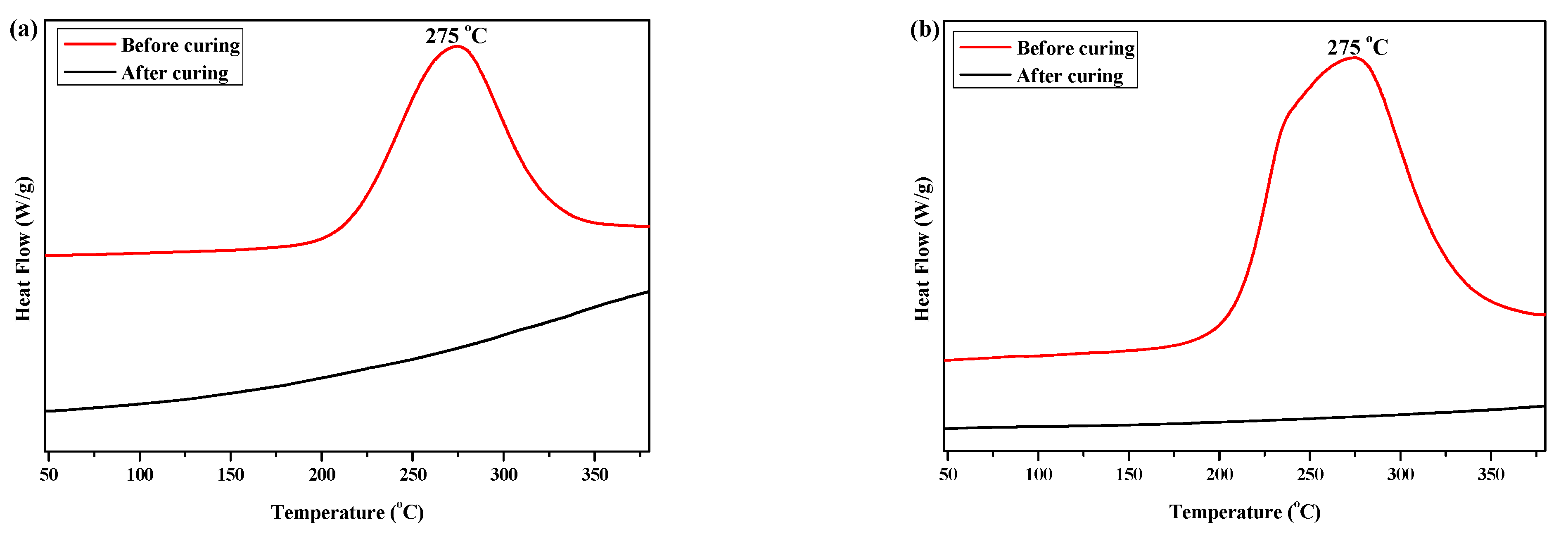
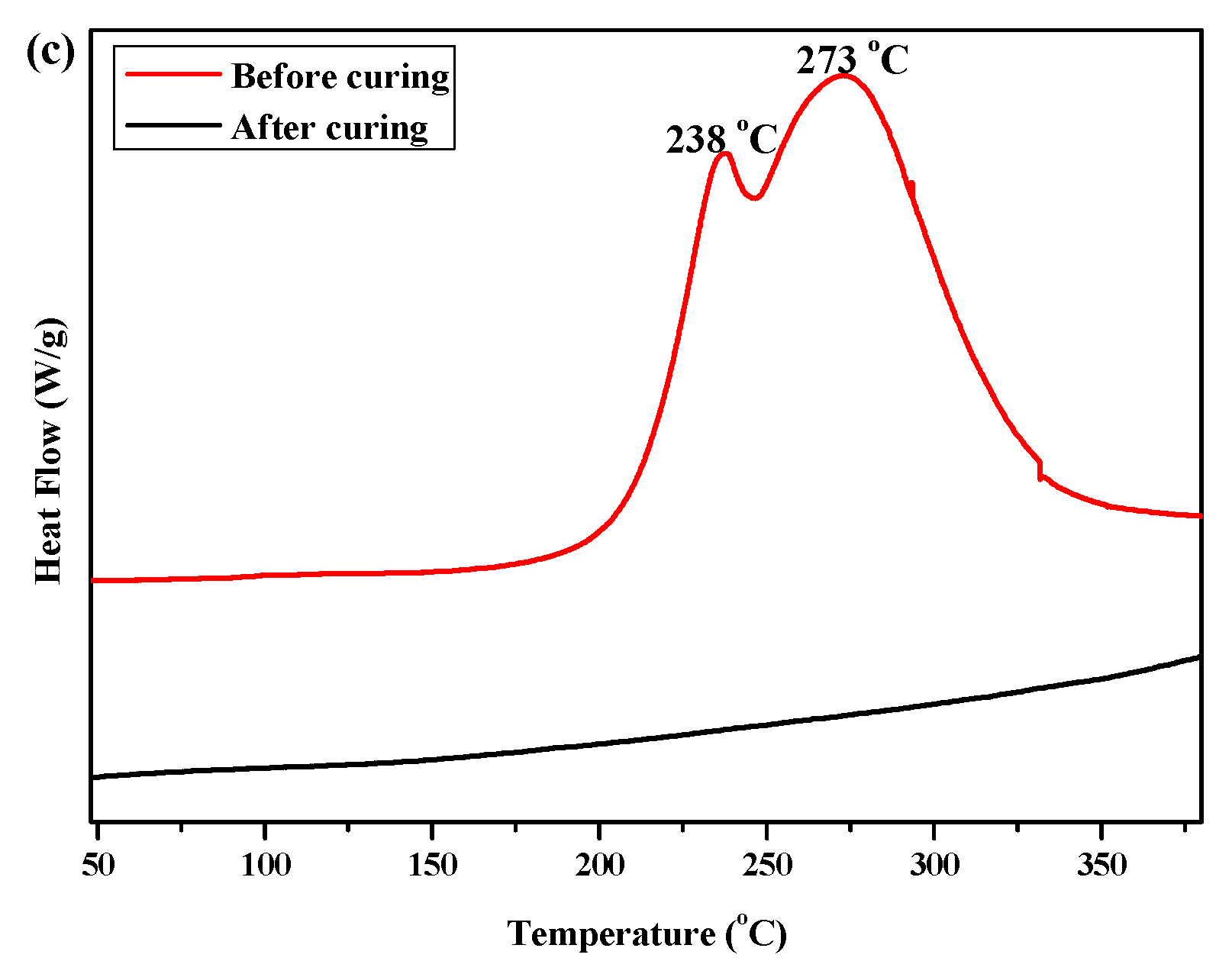
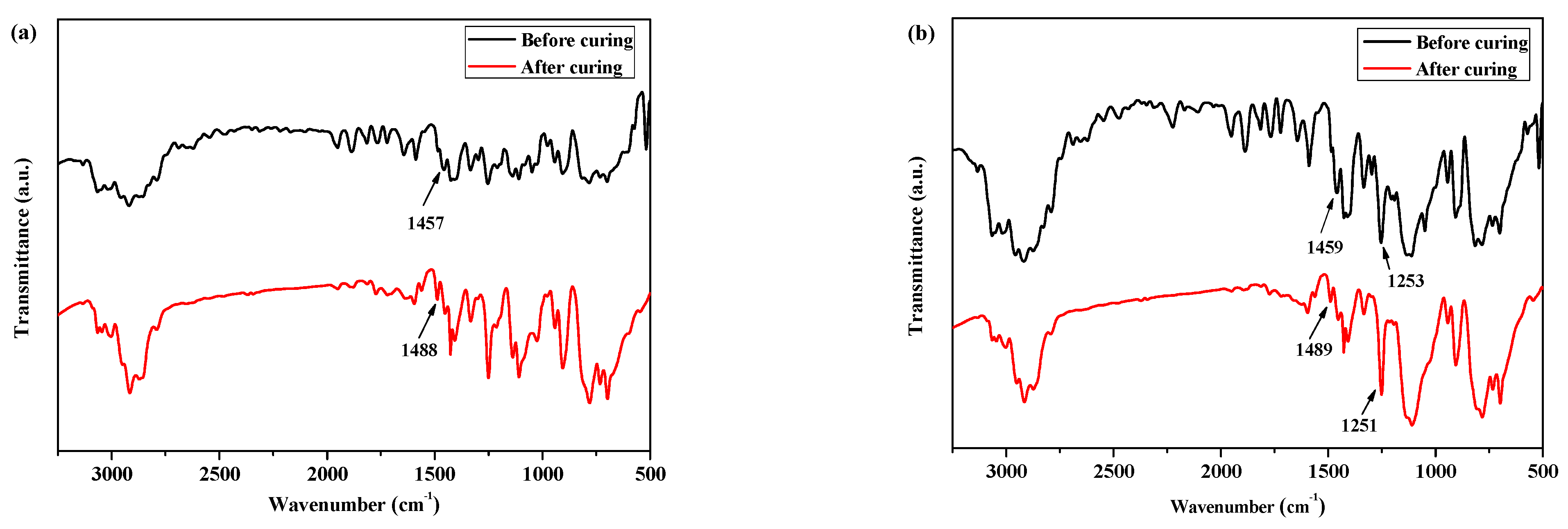
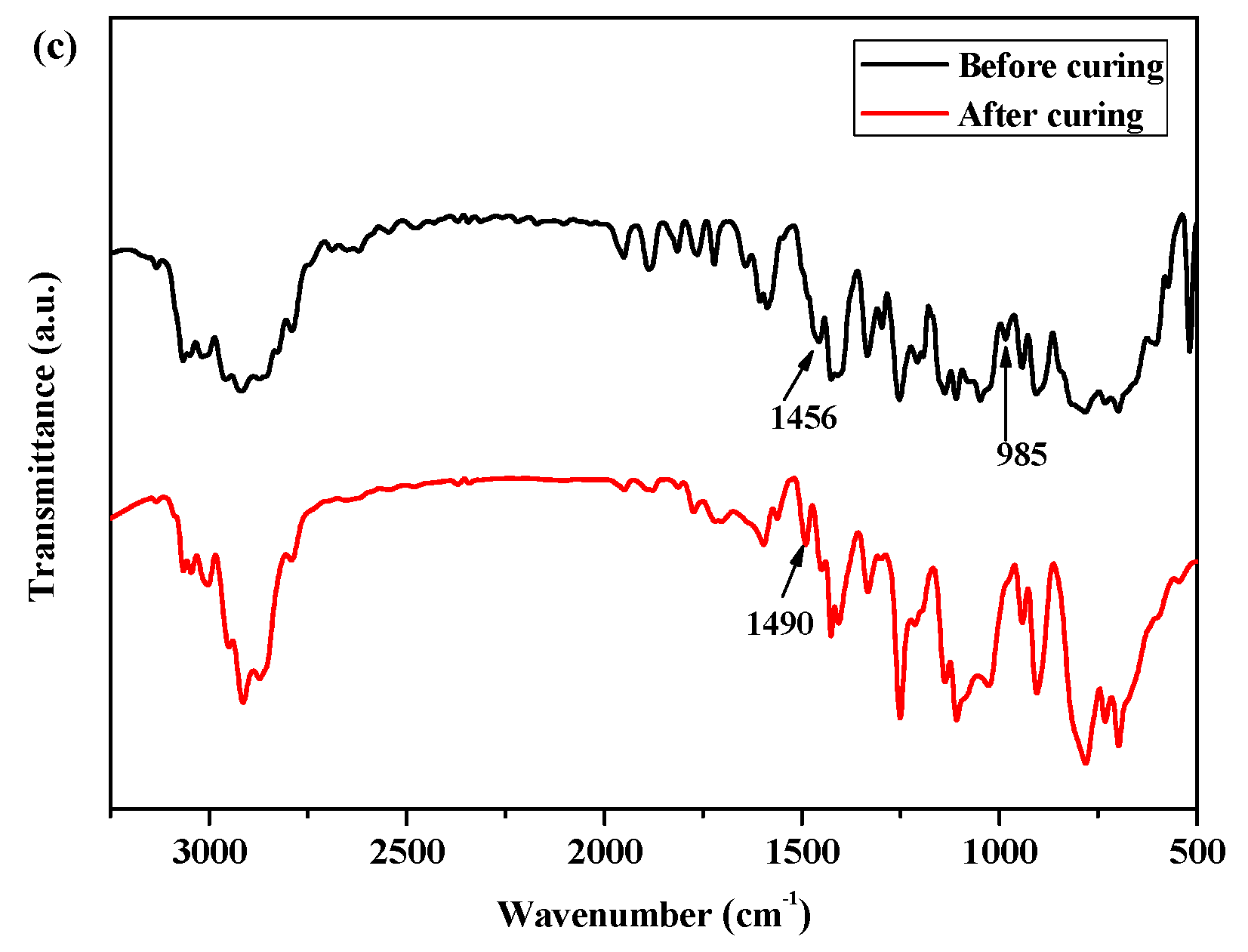
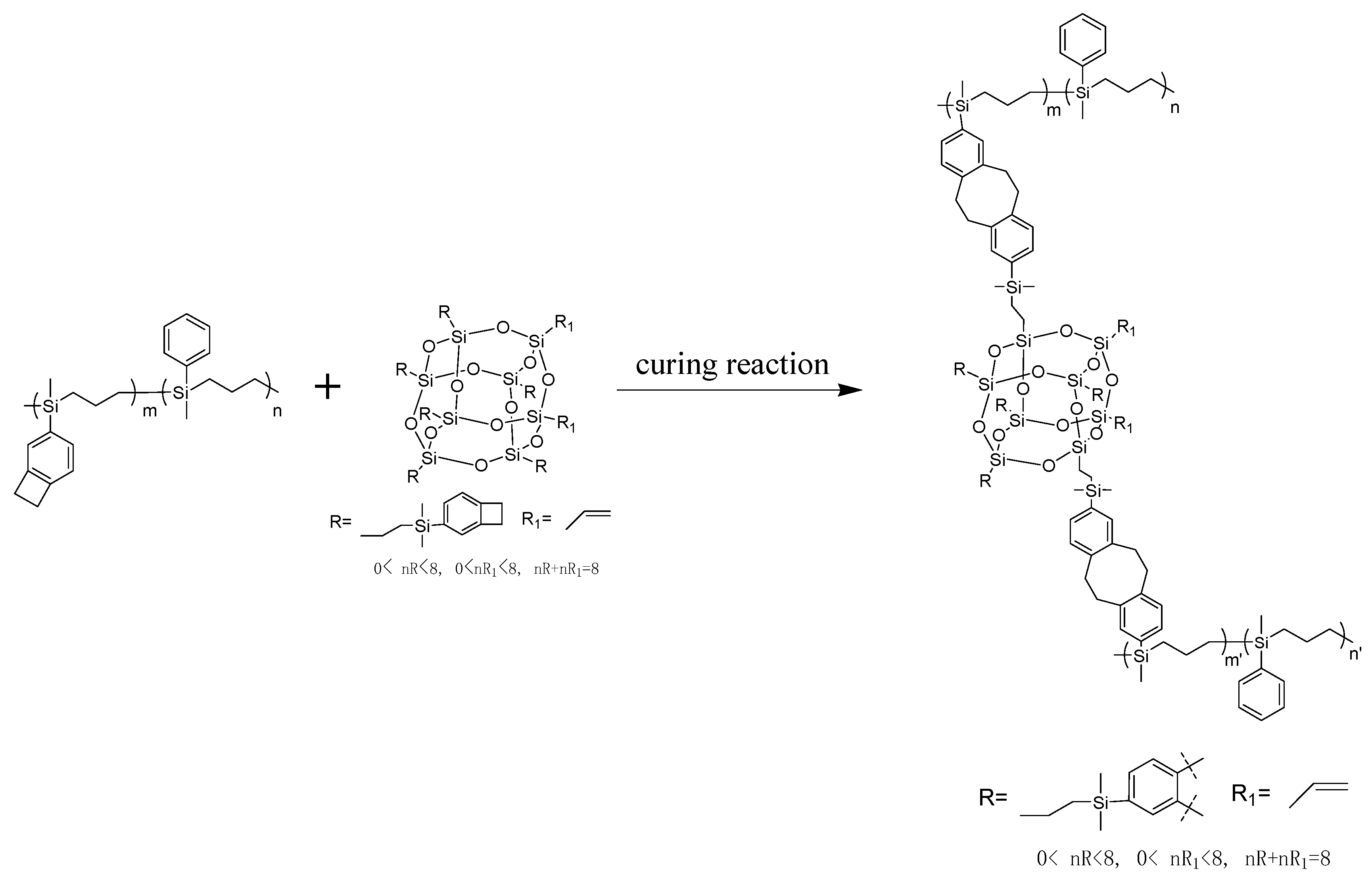
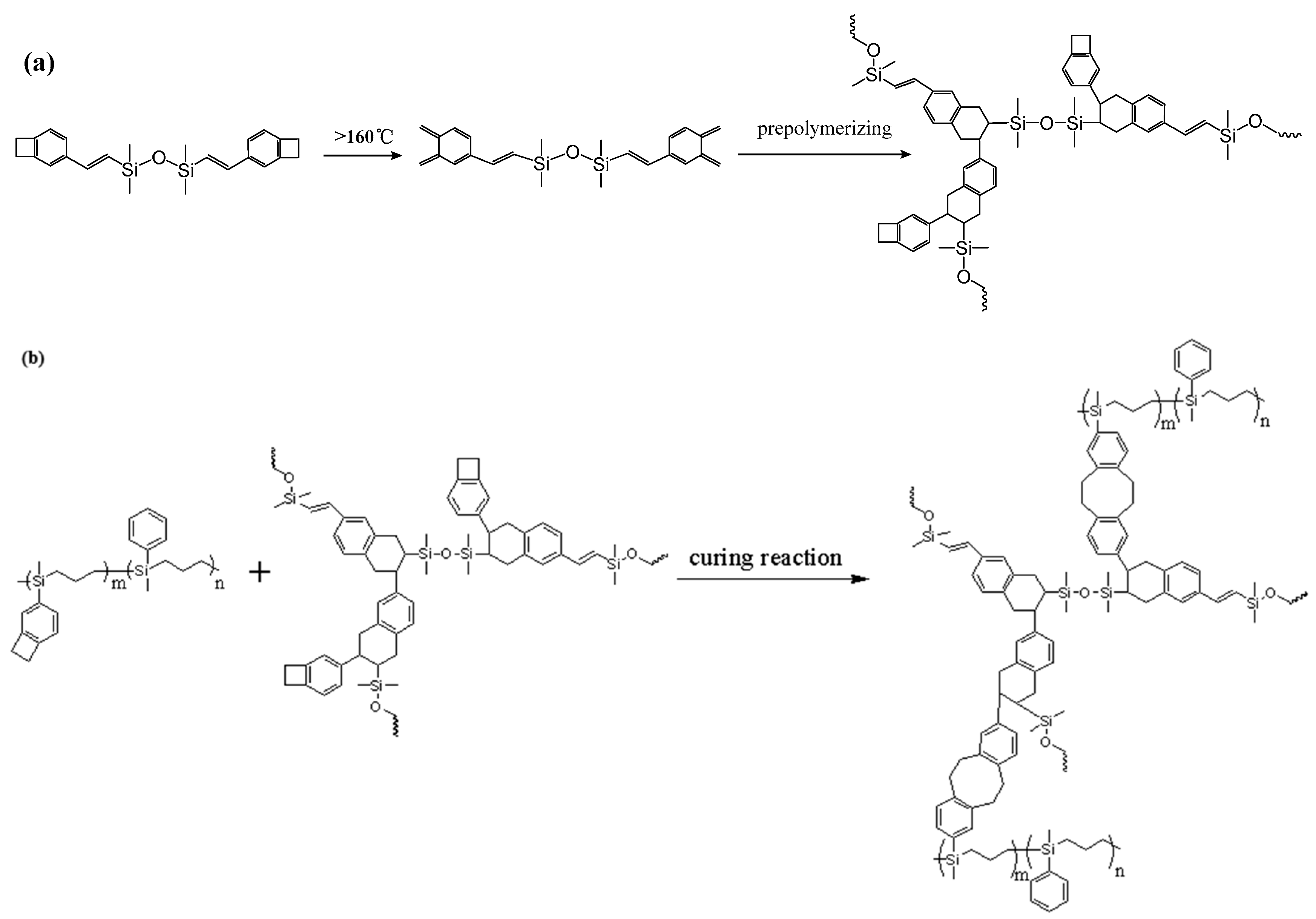
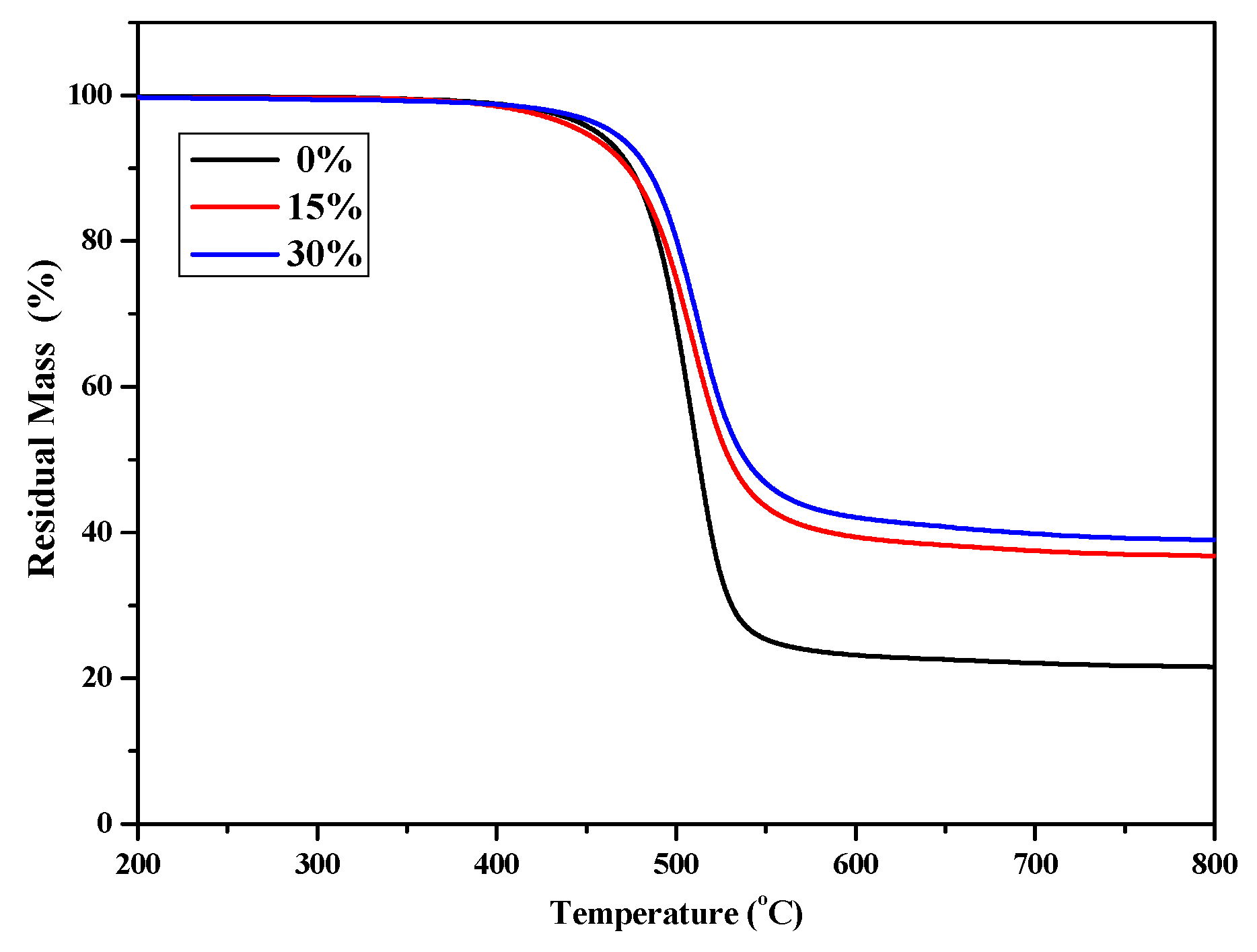
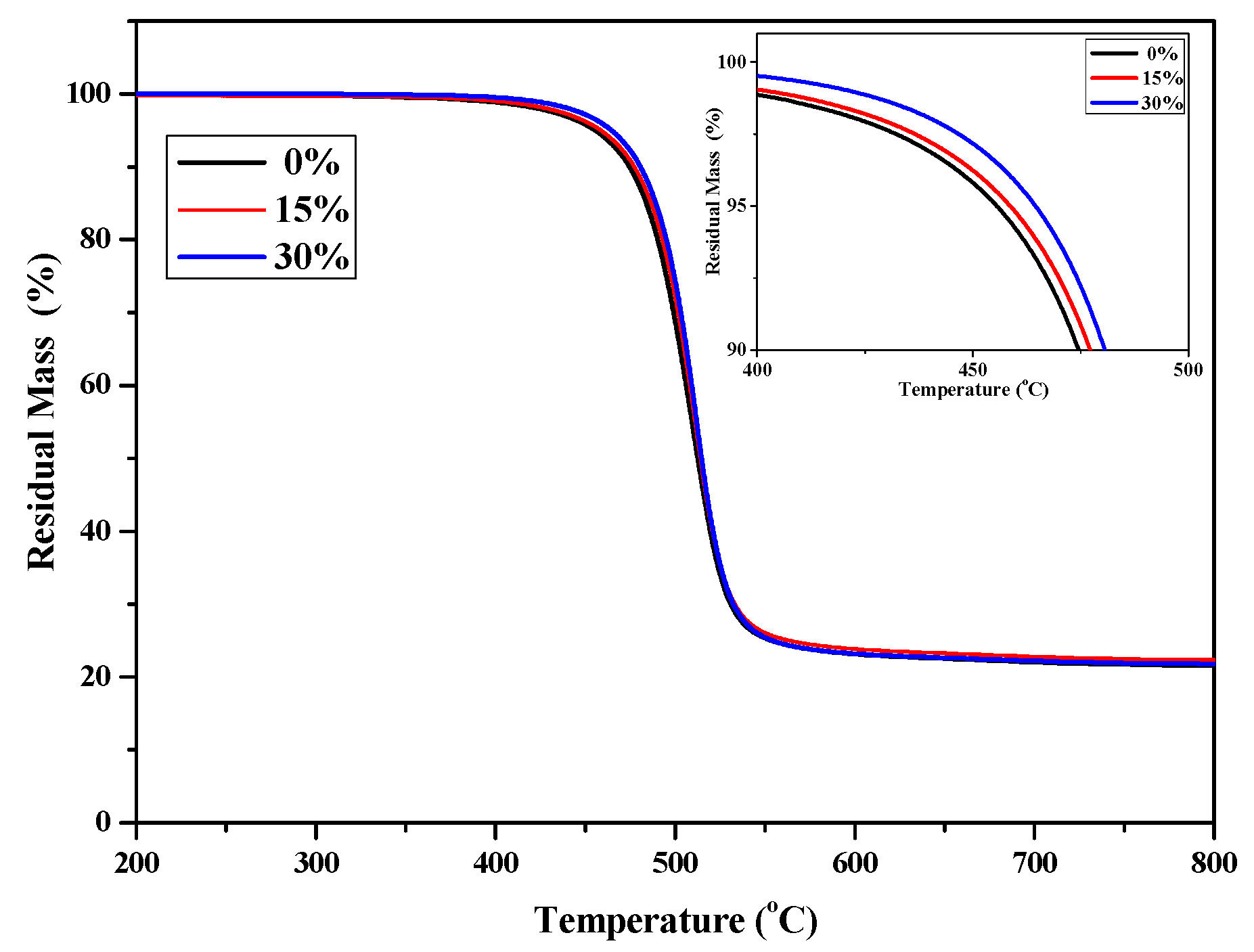
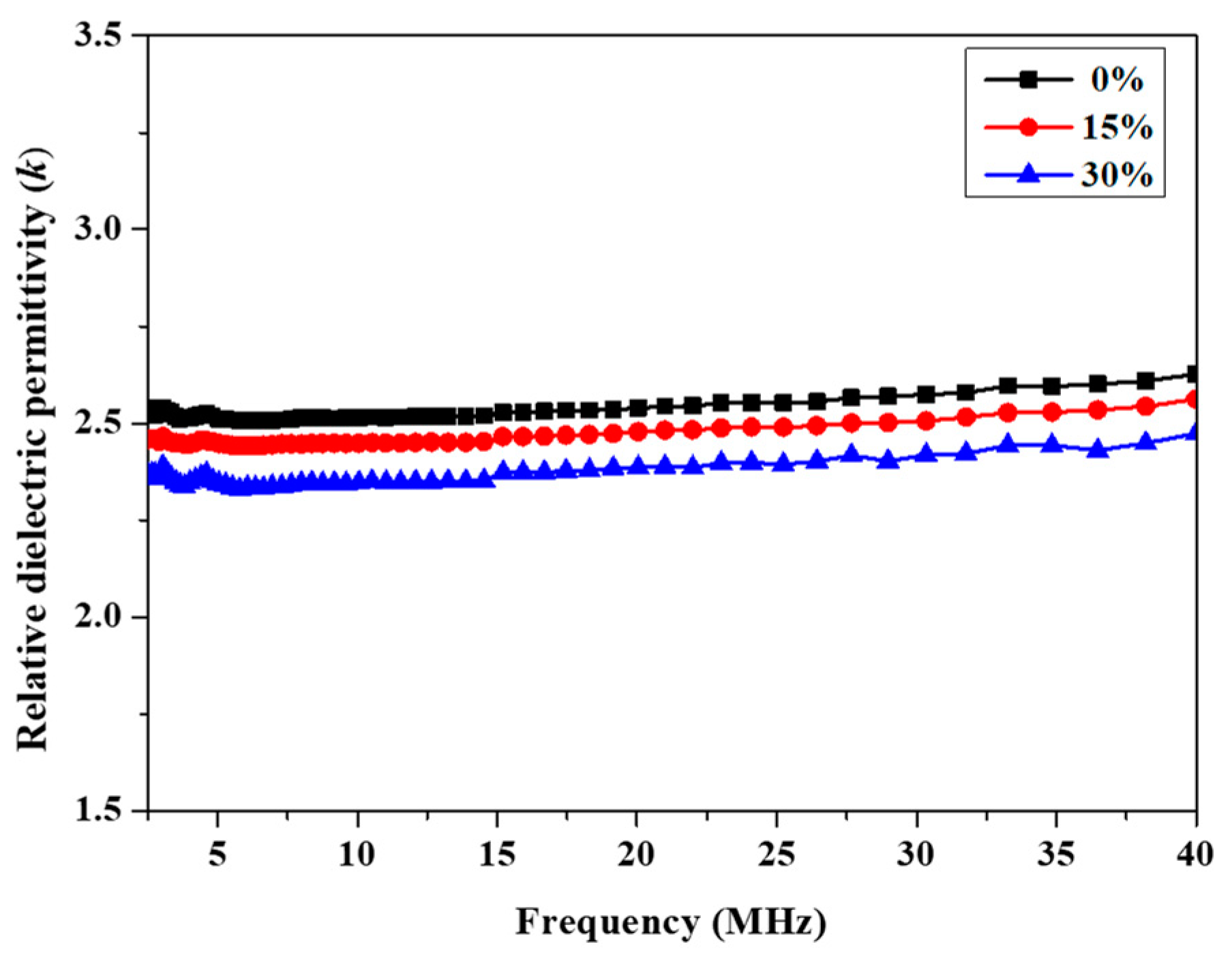
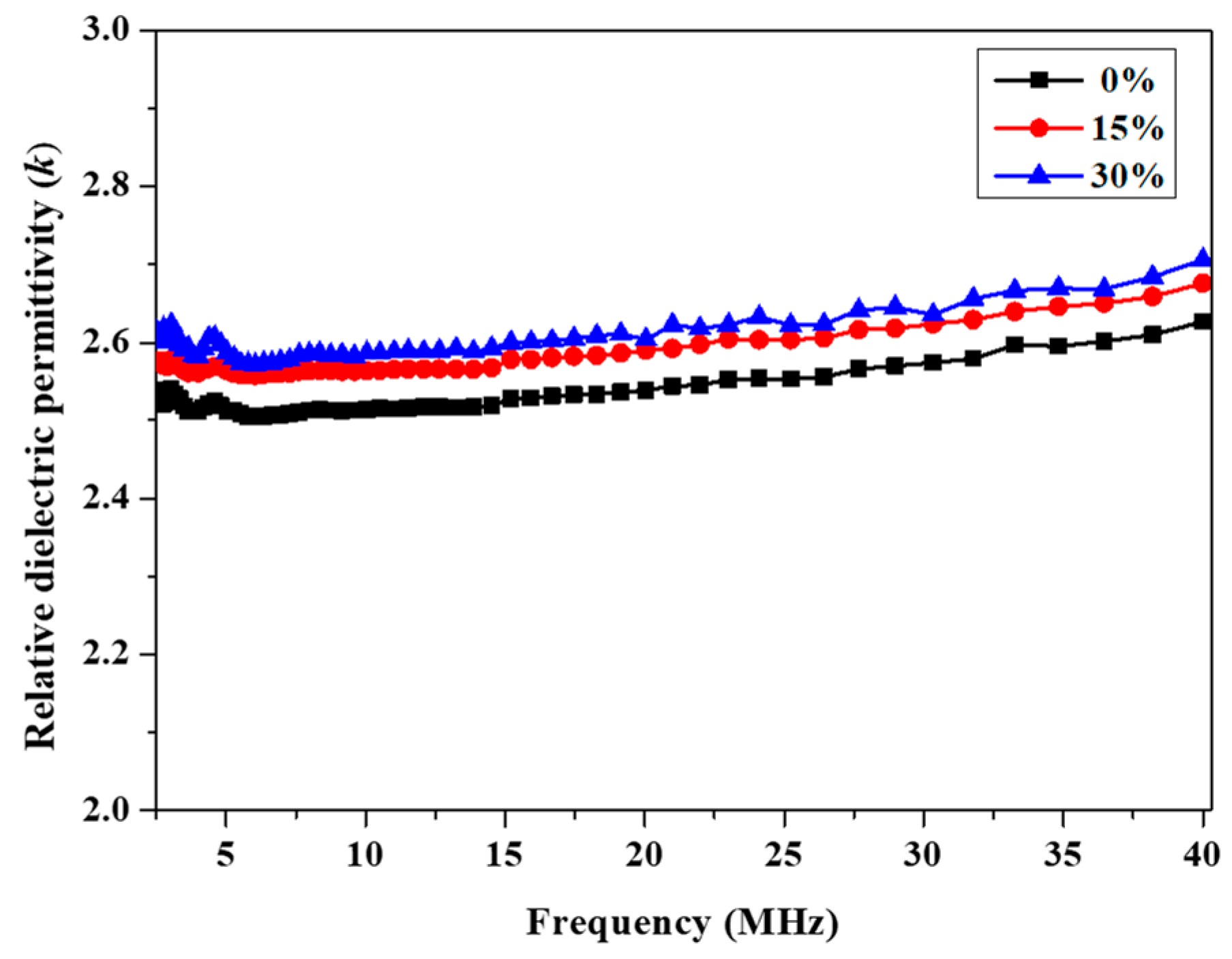
Publisher’s Note: MDPI stays neutral with regard to jurisdictional claims in published maps and institutional affiliations. |
© 2021 by the authors. Licensee MDPI, Basel, Switzerland. This article is an open access article distributed under the terms and conditions of the Creative Commons Attribution (CC BY) license (https://creativecommons.org/licenses/by/4.0/).
Share and Cite
Li, X.; Zhong, N.; Hu, H.; Zhang, Y.; Huang, Y.; Ye, X.; Yang, J. Preparation and Properties of Low Dielectric Constant Siloxane/Carbosilane Hybrid Benzocyclobutene Resin Composites. Materials 2021, 14, 6548. https://doi.org/10.3390/ma14216548
Li X, Zhong N, Hu H, Zhang Y, Huang Y, Ye X, Yang J. Preparation and Properties of Low Dielectric Constant Siloxane/Carbosilane Hybrid Benzocyclobutene Resin Composites. Materials. 2021; 14(21):6548. https://doi.org/10.3390/ma14216548
Chicago/Turabian StyleLi, Xian, Nan Zhong, Huan Hu, Yufan Zhang, Yawen Huang, Xu Ye, and Junxiao Yang. 2021. "Preparation and Properties of Low Dielectric Constant Siloxane/Carbosilane Hybrid Benzocyclobutene Resin Composites" Materials 14, no. 21: 6548. https://doi.org/10.3390/ma14216548
APA StyleLi, X., Zhong, N., Hu, H., Zhang, Y., Huang, Y., Ye, X., & Yang, J. (2021). Preparation and Properties of Low Dielectric Constant Siloxane/Carbosilane Hybrid Benzocyclobutene Resin Composites. Materials, 14(21), 6548. https://doi.org/10.3390/ma14216548





